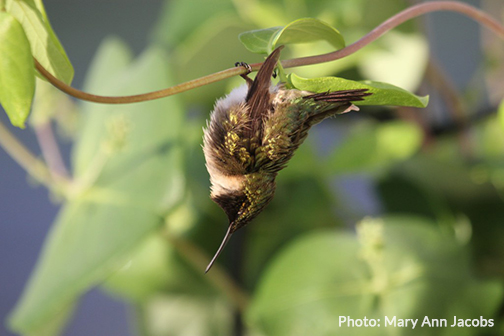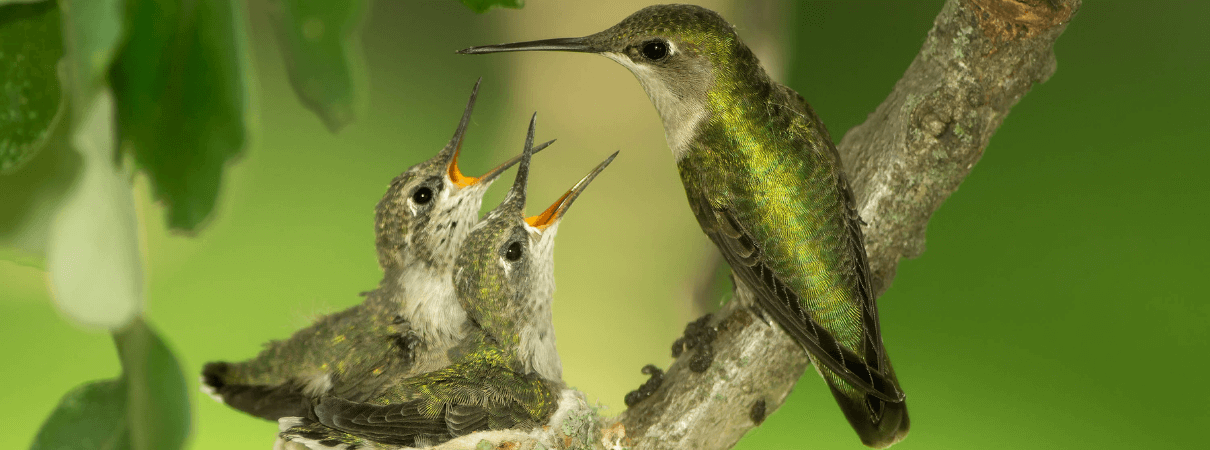Hummingbirds usually seek shelter from rain by finding a safe spot under leaves or branches. Hummingbirds, tiny and delicate birds known for their dazzling flight patterns and vibrant colors, can be found in various regions of the Americas.
One common question that has intrigued bird enthusiasts is where do hummingbirds sleep when it rains? With their small size and fragile bodies, it is understandable that these birds need protection from the impact of raindrops. In order to find a safe haven during rainfall, hummingbirds often seek refuge under leaves or branches of trees.
This strategic move not only helps them stay dry but also protects their delicate plumage from getting damaged. So, the next time you observe a rain shower, take a closer look at the tree canopy and you might just spot a hummingbird tucked away, taking a much-needed rest from its vibrant, high-energy lifestyle.
Natural Habitat Of Hummingbirds
Hummingbirds are fascinating and vibrant creatures that are known for their agility and vivid colors. These tiny birds are found primarily in the Americas, ranging from Alaska to the southern tip of South America. Understanding the natural habitat of hummingbirds helps shed light on their unique behaviors and adaptations to their surroundings.
Preferred Locations For Nesting
Hummingbirds prefer to nest in areas that offer shelter and protection from the elements. They often choose locations near the edges of forests, along streams, and in open woodlands. These locations provide a balance of security and access to the nectar-bearing flowers that form the basis of their diet.
Features Of Hummingbird Nests
The nests of hummingbirds are truly remarkable in their construction. They are typically small and cup-shaped, constructed from materials such as plant fibers, down, and spider silk. The nests are often camouflaged with lichens or moss to blend seamlessly into their surroundings, providing an added layer of protection for the eggs and young chicks.

Credit: www.adirondackcouncil.org
Behavioral Adaptations
When it comes to the behavioral adaptations of hummingbirds, their ability to protect themselves from rain and their unique sleeping positions are fascinating aspects to explore. Hummingbirds have developed clever strategies to navigate through adverse weather conditions, including rain, highlighting their incredible adaptability.
How Hummingbirds Protect Themselves From Rain
Hummingbirds have a remarkable ability to stay dry and maintain their energetic lifestyle even during rainy periods. Their feathers are not only vibrant and iridescent, but they also have a unique structure that repels water. The tiny hooks on their feathers are similar to Velcro and help to prevent water from penetrating through to their delicate skin. Additionally, these little birds can adjust their body position to minimize exposure to rain and will often seek shelter under leaves or overhangs during rainfall.
Unique Sleeping Positions
During rain, hummingbirds showcase their ingenious sleeping positions to maintain their comfort and safety. These agile creatures have been observed perching on branches with their heads tucked under their wings to shield themselves from the rain. In this position, they maintain a low energy state, conserving their energy reserves while waiting for the rain to pass.
Alternative Shelter Options
Alternative Shelter Options:
Finding Cover In Trees And Bushes
Hummingbirds often seek refuge in trees and bushes to shelter from rain.
Using Leaves Or Overhangs As Protection
They also utilize leaves and overhangs to shield themselves from the downpour.
Human-made Structures
In search of shelter from the rain, hummingbirds often seek refuge under leaves or branches of trees to sleep. These tiny birds can also find solace in dense vegetation or even build nests in covered areas of human-made structures.
Utilizing Birdhouses Or Artificial Nests
Hummingbirds are adaptable creatures that can find unique solutions to protect themselves from rain showers. One common strategy is their use of human-made structures. Birdhouses and artificial nests are not only used for nesting, but they also serve as excellent rain shelters for these tiny birds. By taking advantage of the shelter provided by these structures, hummingbirds can stay protected from the rain and continue to rest comfortably.
Seeking Shelter In Garages Or Sheds
Another option that hummingbirds may choose when it starts to rain is seeking shelter in garages or sheds. These spaces provide a safe haven during inclement weather, allowing the hummingbirds to stay dry and away from the elements. The cool and quiet environment of a garage or shed can be particularly appealing to these birds, as they can hide from heavy rain and thunderstorms. However, it is important to note that the doors of these human-made structures should be left slightly open to let the hummingbirds come in and exit freely.
In summary, when it comes to seeking shelter during rain showers, hummingbirds can rely on human-made structures like birdhouses and artificial nests, as well as garages or sheds. These ingenious methods allow the tiny birds to find protection from the rain and continue their natural behaviors without the threat of getting soaked. By creating a safe and dry environment, we can help support these marvelous creatures and ensure their well-being, even during wet weather conditions.
Challenges Faced During Rainy Weather
Hummingbirds face challenges during rainy weather as they need to find shelter to protect themselves from the rain. They typically seek refuge in thick foliage, dense trees, or even under eaves and roofs to stay dry until the rain subsides.
Rainy weather can pose several challenges for hummingbirds, who are known for their small size and delicate nature. These tiny creatures rely on nectar as their primary source of energy, but rain can make it difficult for them to feed. Additionally, wet feathers can weigh them down and impact their ability to fly swiftly and efficiently. While hummingbirds have adapted various strategies to survive inclement weather, understanding the effects of wet weather on them is crucial. Let’s dive deeper into the impact of rainy weather on hummingbirds and the strategies they employ to navigate these challenging conditions.
Effect Of Wet Weather On Hummingbirds
Rainy weather can significantly affect hummingbirds’ ability to feed and maintain their high metabolism. When it rains, nectar-producing flowers may close their blooms or become diluted. This scarcity of available nectar can leave hummingbirds hungry and in search of alternative food sources. Furthermore, rain can wash away insects that hummingbirds rely on for protein, further exacerbating their nutritional challenges.
Moreover, the rain itself can create obstacles for these agile birds. Hummingbirds have waterproof feathers, but prolonged exposure to rain can leave their feathers wet and heavy. This added weight can impede their ability to hover and fly quickly, making it more difficult for them to escape predators or find shelter. Wet feathers can also lead to a higher rate of heat loss, requiring the hummingbirds to expend more energy to maintain their body temperature.
Strategies For Surviving Inclement Weather
Despite these challenges, hummingbirds have developed remarkable strategies to survive and adapt to rainy weather. Here are some tactics these tiny birds employ to cope with adverse conditions:
1. Seeking shelter: During rainfall, hummingbirds take cover in dense foliage, such as thick trees or shrubs. These provide protection from both the raindrops and potential predators, allowing the birds to wait out the storm and conserve their energy.
2. Pre-rain fueling: Hummingbirds possess an impressive instinct to anticipate inclement weather. Before a storm hits, they will actively feed and load up on nectar, increasing their energy reserves to sustain them through the period of limited food availability.
3. Torpor: To conserve energy during extended periods of rain, hummingbirds may enter a state of torpor. Torpor is a deep sleep-like state where the bird lowers its body temperature and metabolic rate. By doing so, hummingbirds can minimize energy expenditure until better weather conditions prevail.
4. Feather maintenance: After the rain subsides, hummingbirds will meticulously groom their feathers. They use their beaks to realign and preen each feather back to its optimal position. This behavior helps restore their feathers’ waterproof quality and ensures efficient flying capabilities.
While rainy weather poses challenges for hummingbirds, their remarkable adaptations and survival strategies allow them to weather these storms. By understanding the effects of wet weather on these delightful creatures and the tactics they employ, we can appreciate these tiny birds’ resilience and admire their ability to navigate nature’s elements.
Credit: www.quora.com
Research Findings
Hummingbirds seek shelter in dense vegetation or use strategically positioned leaves to stay dry during rainy weather. Their ability to find protective spots allows them to rest and avoid getting wet in unfavorable conditions.
Studies On Hummingbird Behavior In Rain
Researchers have conducted in-depth studies on how hummingbirds behave during rain showers. They have observed interesting patterns in hummingbird behavior when it rains, shedding light on their adaptations.
Insights From Birdwatchers And Researchers
Experienced birdwatchers and researchers have provided valuable insights into where hummingbirds seek shelter during rainy weather. Their observations offer a glimpse into the strategies these tiny birds employ to stay dry.

Credit: abcbirds.org
Frequently Asked Questions On Where Do Hummingbirds Sleep When It Rains?
Do Hummingbirds Go Out In The Rain?
Yes, hummingbirds do go out in the rain to find food and bathe. They have waterproof feathers that protect them.
Why Do Hummingbirds Stop Coming To Feeder After Rain?
Hummingbirds avoid wet feeders to prevent mold and bacteria growth. Rain dilutes nectar, making it less attractive. Clean and dry the feeder to bring them back.
Do Hummingbirds Sleep In The Same Place Every Night?
Yes, hummingbirds sleep in the same place every night, usually on a branch or twig. They choose safe and secluded spots to rest.
Do Hummingbirds Know When A Storm Is Coming?
Hummingbirds have keen instincts and may sense changes in air pressure and behavior in anticipation of storms.
Conclusion
In times of rain, hummingbirds seek shelter under leaves or branches to stay dry. Providing small shelters in your garden can help these tiny birds during wet weather. Being mindful of their needs contributes to their well-being and adds beauty to your outdoor space.
- How Many Feathers Does A Bald Eagle Have?
- What Does A Mourning Dove Sound Like?
- What Is The Wingspan Of A Bald Eagle?
- How Hummingbirds Fly The Structure Of A Flight?
- How Long Can A Bird Stay In A Box?
- How Many Eggs Does A Bald Eagle Lay?
- What Do Hummingbirds Do When It Rains?
- When Does A Bald Eagle Get A White Head?
- Do Hummingbirds Come Back To The Same Place Every Year?
- What Sound Does A Mourning Dove Make?
- Diatomaceous Earth for Fleas Reviews
- What Do Bald Eagle Feathers Look Like?
- Where Do Hummingbirds Sleep When It Rains?
- Golden Eagle Compared To Bald Eagle?
- Can You Have A Bald Eagle As A Pet?
- How Much Does A Hummingbird Eat?
- What Sound Does A Bald Eagle Make?
- Do Hummingbirds Open Their Beaks?
- How Do Hummingbirds Sleep?
- What Does A Young Bald Eagle Look Like?

